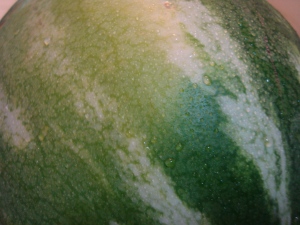Yes, you can eat watermelon rind!
Watermelon rind boosts nitric oxide’s production, which improves arterial blood flow and might reduce blood pressure. In many traditional African cuisines, watermelon flesh and seeds (a source of fatty acids and protein) are cooked and served as a vegetable. I’ve enjoyed pickled watermelon rind -which was sweet and heavily spiced with clove – with cream cheese and crackers.
As a home remedy, the rind can be applied to skin that is suffering from the itch of poison ivy and poison oak for relief.
Watermelon seeds are also edible
Human trials have shown that you can safely eat the seeds without risking sprouting a watermelon tree from your belly button! In some parts of India, the seeds are ground into flour. Watermelon seed tea was once used medicinally for reducing blood pressure and as a diuretic. In Russia, watermelon juice is also processed and enjoyed as an alcoholic beverage.
Watermelon skin absorbs pesticides, so go organic
Even if you don’t plan to eat the rinds – just yet, anyway – people often think that the thick skin of the melon will protect it from the effects of pesticides. Not true! Depending on the variety of melon, its flesh is at least 90% water or more. This means that when your thirsty melon is slurping up every ounce of water it can find, it’s also gulping in any pesticides or other chemicals it encountered during its growing period.
Watermelon vs. Tomato
Watermelon provides about as much lycopene as two medium tomatoes. They are also a fine source of beta carotene. Studies have boosted watermelon’s status, showing that eating it with other fruit, can reduce the risk of colorectal cancer. Eating it with other carotenoid-containing foods can lower the risk of prostate cancer. Watermelon also provides a lot of water and minerals.

-
Tips for selecting a ripe watermelon
- Look for a melon that is heavy and has a hard rind. Be sure it is free of bruises and dents. Look for the spot where it sat on the ground. If the spot is yellow, it was allowed to ripen on the vine longer. If the spot is white, it is less ripe. Unfortunately, watermelons do not ripen off of the vine. The debate continues on as to whether thumping the melon to test ripeness actually works. An uncut melon will keep for up to 2 weeks at room temperature. Store cut melons, covered, in the refrigerator. Watermelon is best when it is grown in season.
Watermelon history
They were highly prized and often buried in the tombs of kings for nourishment in the afterlife. It was likely cultivated around 5,000 years ago among Egyptians, and are found painted in hieroglyphics in buildings. Melons were cultivated for thousands of years in China, Greece, Rome, and the Mediterranean. At long last, they reached the United States with European colonists and African slaves. Now, over 1200 varieties of melons exist, with 200-300 varieties growing in the US and Mexico. Forty-four states now grow watermelon, with the biggest producers being California, followed by Florida, Texas, and Georgia. It’s inner flesh ranges from deep red to pink, orange, yellow, and rarely, white.
Here are some links to other watermelon recipes:
- Tomato-Watermelon Soup with almonds, red-wine vinegar, and feta
- Chilled Watermelon Soup with lime, mint & ginger
- Thai Spiced Watermelon Soup
- Watermelon-Jalapeno Salsa
- Watermelon-Feta Salad
So what do you think? Will you try some pickled watermelon rind this year?
To Your Delicious Health,
Frances



One response to “How to Select a Watermelon”
[…] Here is my post on how to select a watermelon. […]